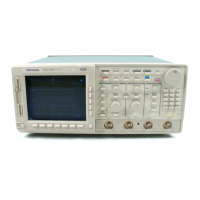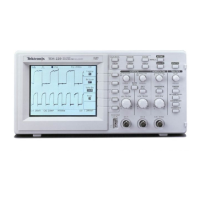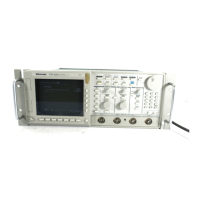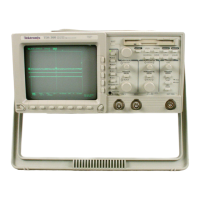Acquiring and Displaying Waveforms
3–40
TDS 500D, TDS 600B, & TDS 700D User Manual
Methods to Check and Eliminate. To quickly check for aliasing, slowly increase
the horizontal scale (time per division setting). If the shape of the displayed
waveform changes drastically or becomes stable at a faster time base setting,
your waveform was probably aliased.
To avoid aliasing, be sure to sample the input signal at a rate more than twice as
fast as the highest frequency component. For example, a signal with frequency
components of 500 MHz would need to be sampled at a rate faster than
1 Gigasamples/second to represent it accurately and to avoid aliasing. The
following tips may help you eliminate aliasing on a signal:
Try adjusting the horizontal scale.
Try pressing the AUTOSET button.
Try switching the acquisition mode (in the acquisition menu) to Envelope or
Peak Detect. Envelope searches for samples with the highest and lowest
values over multiple acquisitions; Peak Detect mode does the same but in a
single acquisition. Either can detect faster signal components over time.
Try pressing the DPO acquisition button (TDS 500D and TDS 700D models
only). DPO mode results in waveform displays similar to those obtained
using an analog oscilloscope.
Customizing the Display
The TDS Oscilloscope can display waveform records and other display elements
in different ways. This section describes how to adjust the oscilloscope display
style, intensity level, graticule, and format.
NOTE. TDS 500D and 700D models only: This section assumes you are using
Normal acquisition mode and gives display settings for this mode. If you select
DPO acquisitions, procedures for making Style, Format, and Readout display
settings differ and some selections are not permitted. See Using DPO
Acquisition Mode, on page 3–59, for setup differences, and Incompatible Modes
on page 3–66.

